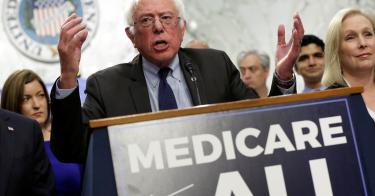Socialism is expensive. In a new cost analysis, Charles Blahous, formerly a member of the Medicare board of trustees, concludes that Vermont Sen. Bernie Sanders’ “Medicare for All” bill (S. 1804) would cost a breathtaking $32.6 trillion over 10 years.
Given the growing commitment of House and Senate Democrats to this agenda, Blahous’ analysis is timely. His assessment of the federal government’s financial burden is also consistent with two other independent analyses.
Two years ago, the Urban Institute, a highly respected liberal think tank, estimated the total cost of the Sanders proposal at $32 trillion over 10 years, and professor Kenneth Thorpe of Emory University, a former adviser to President Bill Clinton, estimated the cost at $24.7 trillion.
In both cases, the analysts estimated that the level of taxpayer funding would be much higher than Sanders and his colleagues assumed.
Central Control
Co-sponsored by 16 leading Senate Democrats—including Sens. Kamala Harris of California, Elizabeth Warren of Massachusetts, and Cory Booker of New Jersey—the Sanders bill is the quintessential prescription for comprehensive government-controlled health care.
In the House of Representatives, 123 Democratic members, more than half of the House Democratic Caucus, have co-sponsored similar legislation (H.R. 676).
The Sanders bill would create a national health insurance program; prohibit all Americans from having a private or employer-based health insurance plan; and abolish Medicare and Medicaid, absorbing their functions into the new national health insurance scheme.
The bill would mandate that doctors, hospitals, and medical professionals be paid Medicare payment rates, and would restrict private agreements between doctors and patients outside of the national system.
Bottom Line
The $32.6 trillion in additional federal spending (2022 to 2031) alone would equal 10.7 percent of the national economy, as measured by the gross domestic product, and would rise to 12.7 percent of GDP by 2031.
Blahous grants Sanders and his Senate co-sponsors the benefit of the doubt. His estimates assume that their bill would be successful in reducing revenues going to doctors, hospitals, and other medical professionals. He also assumes that their legislation would achieve its goals of reducing the cost of prescription drugs as well as administrative costs.
Blahous cautions, however, that drugs account for only 10 percent of total national health expenditures, and the bill’s intention to replace brand names with generics would take effect within a market where generics already make up 85 percent of drugs sold.
Uncertain Savings
Concerning administrative costs, the replacement of private insurance with a single government program would, in theory, secure major administrative cost reductions. For the sake of his estimates, Blahous projects a substantial 7 percent reduction in administrative costs.
There are, he warns, methodological problems in simple comparisons between Medicare and private-sector administrative costs.
Moreover, the major government programs are plagued by persistent administrative failures that routinely jack up administrative costs. Medicare and Medicaid, for example, racked up an estimated $96 billion in improper payments in 2016 alone.
“Although government also polices fraud within its health insurance programs,” Blahous observes, “financial survival and business competitiveness are concerns from which government-provided insurance is generally exempt.”
Even assuming gains from reductions in administrative costs, drugs, and the big reductions in provider payments, other features of the legislation, such as the abolition of all cost-sharing, would drive the costs of the program upward.
Huge Taxes
Taxpayers would face enormous burdens, assuming Congress enacted and the president signed the Sanders bill. In his earlier analysis, Thorpe estimated that those taxes would amount to 20 percent of payroll, and roughly 70 percent of working households would pay more than they do today.
For his part, Blahous says that the costs would be such that “doubling all federal individual and corporate income taxes going forward would be insufficient to fully finance the plan, even under the assumption that provider payment rates are reduced by over 40 percent for treatment of patients now covered by private insurance. Such an increase in the scope of the federal government operations would precipitate a correspondingly large increase in federal taxation or debt and would be unprecedented if undertaken as an enduring commitment.”
The promise of “something for nothing” is always appealing, but it’s never cheap.
This piece originally appeared in The Daily Signal




